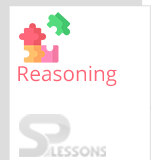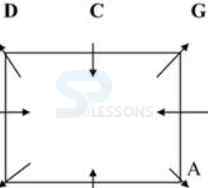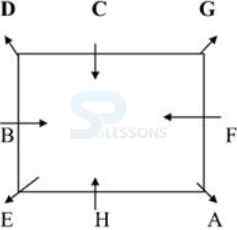 Introduction
Introduction
What is Reasoning Ability Test?
A logical reasoning test is a form of psychometric testing that is widely used by corporate employers to help assess candidates during their recruitment process. 'Psychometric' is just a fancy way of saying 'measuring mental ability' and logical reasoning tests are designed to measure your non-verbal skills.
The article SSC CPO Reasoning Ability Quiz 4 provides Reasoning Ability questions with answers useful to the candidates preparing for Competitive exams, Entrance exams, Interviews etc.
 Quiz
Quiz
Direction(1-5): For the following questions:Answer the following questions based on the statements given below.
Eight horses of eight different colors – red, yellow, green, blue, violet, pink, brown and white are tied on two sides of a road. There are four horses on each side of the road and each horse is facing another horse on the other side of the road. Further the following information is known about the houses.
1) Pink colored horse is diagonally opposite to brown colored horse and they both are on the ends.
2) Red colored horse is opposite to yellow colored horse and is on the same side as the green colored horse.
3) Violet colored horse is opposite to the white colored horse but is not on the same side as the blue colored horse.
4) Blue and brown colored horses are on the same side of the road.
1. How many horses are there between Blue and brown horses?
2. Answer - Option B
3. Answer - Option D
4. Answer - Option C
5. Answer - Option B
- A. 0
B. 1
C. 2
D. 3
E. None of the above
- A. pink and Violet
B. blue and green
C. yellow and green
D. red and green
E. violet and green
- A. pink and brown
B. blue and green
C. yellow and green
D. red and green
E. None of the above
- A. Red
B. Pink
C. Green
D. Blue
E. None of the above
- A. Red
B. Pink
C. Green
D. Blue
E. None of the above
| PINK | VIOLET/RED | VIOLET/RED | GREEN |
| BLUE | WHITE/YELLOW | WHITE/YELLOW | BROWN |
Direction(1-5): Study the following arrangement carefully and answer the questions given below:
Eight friends- A, B, C, D, E, F, G and H are sitting around a square table in such a way that four of them sit at corners of the table while the other four sit in the middle of the four sides. Those who sit in the middle of the four sides face the centre while those who sit at the corners of the four sides face outside. A sits third to the left of C, who does not sit at any of the corners and C is an immediate neighbour of G. E sits to the left but not on the immediate left of F, who is not an immediate neighbour of C and E. B and H are not the immediate neighbors of each other and H is an immediate neighbour of A and E. A and D are also not immediate neighbour of each other. D does not sit in the middle of any sides and at least two persons can sit between A and D. E and G sit opposite to each other but do not face each other. F cannot sit opposite C.
1. H sits third to the left of whom?
- A. B
B. F
C. D
D. C
E. None of these
- A. Third to the left
B. Third to the right
C. Fourth to the left
D. Second to the right
E. None of these
- A. HG
B. GA
C. BE
D. AH
E. None of these
- A. H
B. G
C. D
D. E
E. None of these
- A. B
B. H
C. F
D. C
E. None of these
1. Vincent has a paper route. Each morning, he delivers 37 newspapers to customers in his neighborhood. It takes Vincent 50 minutes to deliver all the papers. If Vincent is sick or has other plans, his friend Thomas, who lives on the same street, will sometimes deliver the papers for him.
- A. Vincent and Thomas live in the same neighborhood.
B. It takes Thomas more than 50 minutes to deliver the papers.
C. It is dark outside when Vincent begins his deliveries.
D. Thomas would like to have his own paper route.
E. None of these
- A. Taxol is poisonous when taken by healthy people.
B. Taxol has cured people from various diseases.
C. People should not eat the fruit of the Pacific yew.
D. The Pacific yew was considered worthless until taxol was discovered.
E. None of these
- A. Only argument I is strong
B. Only argument II is strong
C. Either I or II is strong
D. Neither I nor II is strong
E. Both I and II are strong
- A. Only argument I is strong
B. Only argument II is strong
C. Either I or II is strong
D. Neither I nor II is strong
E. Both I and II are strong
- A. 12
B. 14
C. 27
D. 53
E. 44






